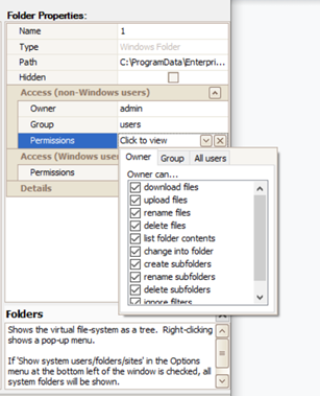Virtual file system
CompleteFTP uses a virtual file system, which means administrators can build their own view of what the file system should be on top of a range of different physical file systems such as disks and network folders.
CompleteFTP file system can be customized to suit your business
The flexibility of virtual folders means that the CompleteFTP file system can be configured for your business requirements. The following folder types are supported:
- Windows Folders (standard Windows folders)
- Windows special folders (folders such as My Documents)
- Network/Macro folders (UNC [network] folders, or folders with an expanded macro). These are not supported in the Free Edition
- Gateway folders (folders that are mounted from remote FTP/FTPS/SFTP servers. These are only available in Enterprise MFT.
- Virtual folders don't exist on the actual file system - they permit a virtual folder structure to be created
- Custom folder-types and file-system extensions may be developed in Enterprise MFT.
CompleteFTP also allows macros to be inserted into the name of any folder in the virtual file-system for automatic substitutions. A common case where this may be useful is in setting the name of the home-folder of Automatic Windows Users, such that the user-name matches the name of the folder that they see when they log in.
Each folder can be configured with a whole range of permissions as well as being able to set virtual folder permissions independently from windows folders which are allocated their own permissions at the windows directory level. Permissions for users logging in via their Windows account may optionally be controlled by Windows.
